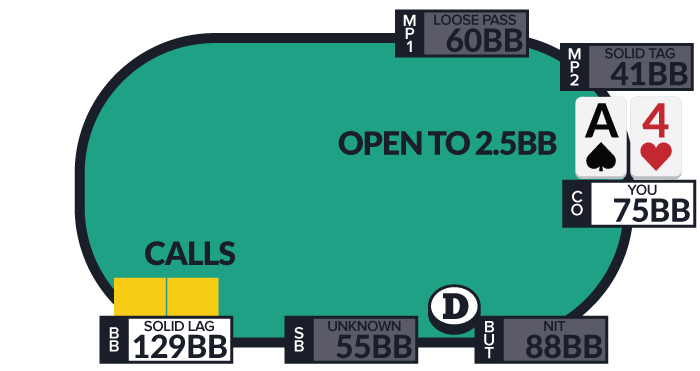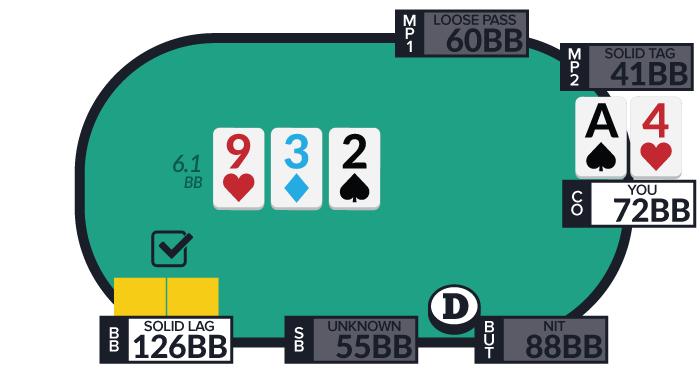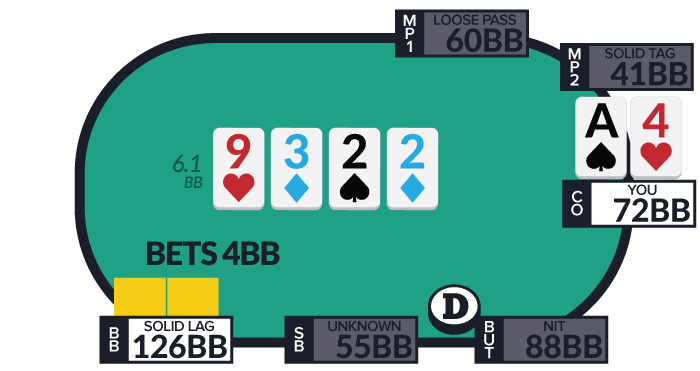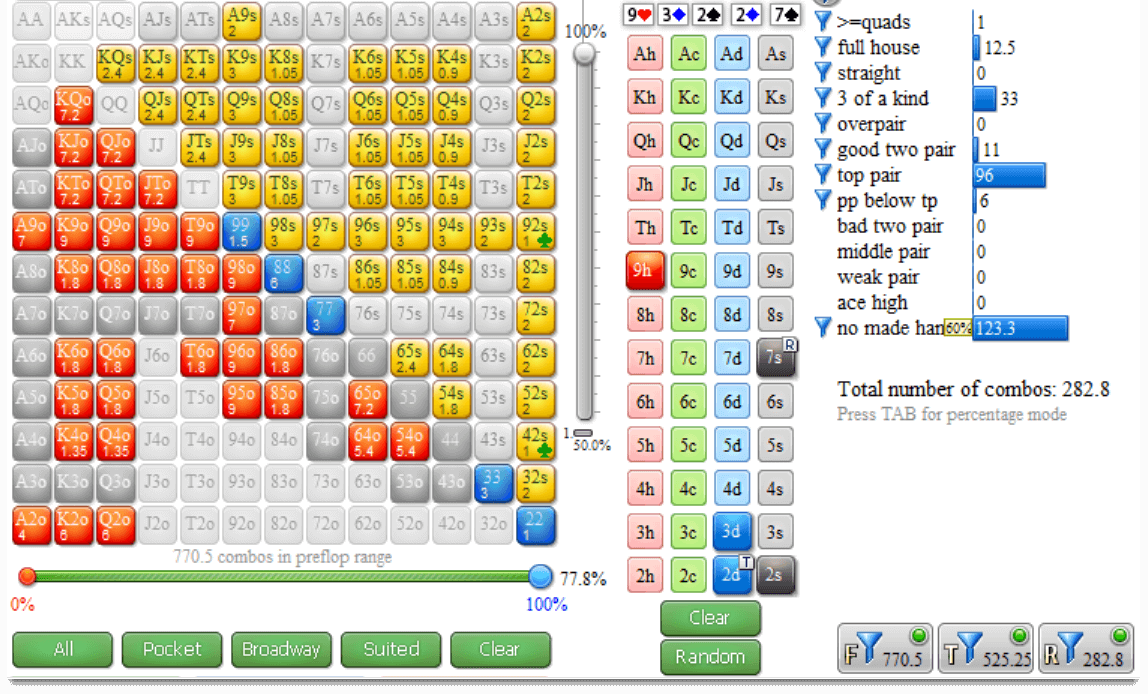Ace-high is always tricky. Any Ace-high hand, even Ace King, is going to miss the flop completely and end up as nothing more than high card more often than not. But solid players understand when Ace-high actually has showdown value. They know when to ditch this hand and when to call it down facing postflop pressure. So today, I’d like to take you behind the play and show you the ranges and assumptions that make calling down with Ace-high a profitable play.
To do this, we’ll explore hand #20 from the new Tournament Final Tables Workbook.
This is the final table of an $82 online tournament. Starting off, let’s plug the basic information into HRC. We see that our 75BB stack is worth 17% of the prize pool given that we are 3rd in chips. Also take notice that the chip leader in the big blind, even though they have an almost 50BB lead over us, only has 21% of the prize pool. And finally, we are playing for $1,800 up top and we are guaranteed $440 if we bust this hand.

It folds to you and you steal with A4o. You are viewed as nitty-TAG since you’ve been card dead at this table and the LAG in the BB has been controlling the action thus far. You steal and it folds to the BB who calls. Note that there is a 10% ante for each player, so the BB is getting a sick price to call here.

The first thing this poker workbook prompts you to do is assign a calling range for the BB here. To help with this, let’s answer the first 3 prompting questions:
1. Do you think the BB calls or 3bets with A4s? Calls.
2. Do you think the BB calls or 3bets with 99? Calls half the time.
3. Do you think the BB calls or 3bets with 98o? Calls.
I think the BB is calling with pretty much everything other than pure offsuit trash here, minus monsters like TT+/AQ+ and half 99 that they would 3bet with. They are getting a sick price, stacks are plenty deep enough, and there is very little reason to think they would fold often imo.
Yes, that’s a very wide range of hands and not one that I normally assign. But when players who understand defense are getting great prices closing action the big blind – it’s not uncommon to see super wide preflop ranges for them.
On the flop, the BB checks to us and we actually end up checking behind.
Most players ignore range building at this point, but there are two crucial things to consider:
1. Does the BB lead with any hands (if yes, remove those leading combos from their checking range)
2. What would the BB assume about OUR range if we checked behind?
I personally assume the BB doesn’t lead much on the flop. Most players just check to the preflop raiser and I have zero reasons to think that this player is going to lead often.
The second question is more curious and actually sets up the rest of the hand. We should assume that anyone we deem as ‘solid’ is trying to put us on a range just as much as we try to put them on a range. So if we check behind, what do we represent?
Most players assume our check behind is weak. I mean, if you had 98, JJ, or AA you’d probably CB, right? That means the average player has a check-behind range that has VERY little strength in it which makes giving action to a bet turn/bet river range quite difficult.
One way to combat that issue is by seeding some hands that can continue against a bet turn/bet river line in your flop checking range. So checking A4 here allows you to actualize your equity more fully, takes away any chance of getting check-raised off your equity, and seeds in ace-high combos that can contend on future streets.

As for building the BB’s checking range, I assume pretty much all combos check and thus their large range continues on to the turn. Note the combos drop a bit due to card removal after seeing the flop cards.
On the turn, the checking stops. The BB leads for 4BB, or 2/3 pot.

At this point, the workbook prompts three questions to get you thinking about the BB’s betting range:
1. Do you think the BB bets or checks with KT? Bets sometimes (always bets diamonds).
2. Do you think the BB bets or checks with 65? Bets.
3. Do you think the BB bets or checks with Q9? Bets.
These 3 questions get you thinking about the three major kinds of hands villain can have here; air, draws, and pairs. And if the BB would fire out with top pair, it’s likely he would also fire with trips – so it allows you to estimate the fuller width of the range just by answering that single question.
In this spot, after we show weakness on the flop, I assume the average LAG is going to bet the next street often. This is something that hints at a wide betting range on the turn, and is something that we should have planned for before checking the flop behind.
Given a number of hands the BB can have preflop, and gets to this turn card with, they can have a good chunk of hands that beat us – from 33 to 95s, they can show up with hands that smash our ace-high. But there is zero reason to believe that the BB never bluffs here. In fact, I would say you should expect the BB to bluff here often after you show weakness on the flop. To that end, I actually only decided to add 25% of all bluff hands (ranging from Ace-highs that beat us to J8 which we crush). Even with only 25% of bluffs included, our A4 has 48% equity and thus we are certainly continuing with our Ace-high…
We call the turn and end up facing a pretty large bet on a 7♠. Now what?

Well most people panic here, grumble something along the lines of ‘nice catch’ and muck.
But should we really fold Ace-high here?
Let’s break it down and answer the prompting questions:
1. Do you think the BB bets this large with KT? Sometimes.
2. Do you think the BB bets this large with A2? Yes.
3. Do you think the BB bets this large with 7♦5♦? No.
Again, you notice these questions get you thinking about large portions of villain’s possible range. Essentially, what size does the BB choose here with air, super strong hands, and medium pairs? Is the BB the kind of player to choose multiple sizing strategies on the river? Or the kind of player to just use a single size when betting here?
Truth be told, most players use different bet sizing with different parts of their range – but they don’t balance each range. They either bluff large and don’t value bet large with enough combos, or they VB for a normal size and don’t add in enough bluff combos. Either way, they have a gap in their strategy that we can exploit.

In this spot, I don’t think the BB is firing almost pot with 3x or 7x hands. He likely puts us on a bunch of high-card hands and/or busted draws and doesn’t assume he can value bet hands like that (little does he know we are capable of calling with ace-high when correct, which would totally flip his mindset about value betting any pair here). So I personally assume this bet is very polarized.
That being said, there are actually quite a few value betting combos available. If we assume 88, 9x, 2x, boats, etc. are all value combos in his eyes, that gives the BB about 160 value combos. And since we are getting roughly 2:1 on a call here, we need villain to have at LEAST 80 combos of air for us to call this.
Well the BB gets to the river with 525 combos. And after subtracting the ~120 combos of 7x and 3x kind of hands, there are still heaps of bluff combos for the BB to decide to turn into a bluff.
So one of two things happens on the river:
1. The BB fires few bluffs and thus checks a LOT
2. The BB fires a lot of bluffs to contend for the pot
Given their LAG nature, I think we can expect a good chunk of bluffs. So I factored in bluffs with any non-Ace high hand (including King-high hands, Queen-high hands, etc.) at a 60% frequency. That gives us 120 combos of air, which is MORE than enough for us to expect to make a +EV call on the end.
Notice how this entire exercise forced us to work through the problem step-by-step. Each question we asked and then answered allowed us to narrow in on villain’s range. We used context clues about villain’s tendencies to estimate how wide ranges were, especially bluffing ranges after we showed weakness. We built a preflop range before we built a turn range. We accounted for our opponent hand reading us (or at least trying to) to deduce their range even better.
Also, there are two other big things to consider:
1. If the BB fires more bluffs on the turn, his river issue is even more amplified
2. If the BB views some weaker 9x hands to be SDV/bluff-catchers, that caps their VBing range
I know this is a lot to digest. But the honest truth is that these things become more automatic as you practice them more. The more exercise you do, the more times you explore the technical elements of a range, the more times you explore the breakeven points in a range – the more you can actually use this stuff in real-time.
Your goal is not perfection in real-time.
Your goal is to be close enough that you can objectively gauge good vs. bad vs. better lines at the table.
And that’s exactly why I created this tournament workbook. I wanted to make it easier for you to study the right stuff and to develop the right kind of questions to ask yourself in real time to ensure you focus on the right things. It doesn’t matter if you want to light 3bet more, find thinner value bets, or even find correct call downs with Ace-high. Every play you want to make revolves around solid hand reading. The better you get, the easier it is to find profitable plays.
So grab your copy of the workbook and start studying the right stuff between sessions. Force your opponents to suckout on you in order to bust you, never make the mistake of letting your strategy mistakes bust you out again.
GLGL with your exploration ♥

